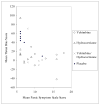Effects of yohimbine and hydrocortisone on panic symptoms, autonomic responses, and attention to threat in healthy adults
- PMID: 19266185
- PMCID: PMC2740930
- DOI: 10.1007/s00213-009-1475-x
Effects of yohimbine and hydrocortisone on panic symptoms, autonomic responses, and attention to threat in healthy adults
Abstract
Rationale: Research in rodents and non-human primates implicates the noradrenergic system and hypothalamic-pituitary-adrenal axis in stress, anxiety, and attention to threat. Few studies examine how these two neurochemical systems interact to influence anxiety and attention in humans.
Objective: The objective of this paper is to examine the effects of exogenous yohimbine and hydrocortisone, as well as their combination (Y + H), on panic symptoms and attention to social threat cues.
Methods: Thirty-two healthy adults underwent a pharmacological challenge in which they were blindly randomized to either yohimbine, hydrocortisone, Y + H, or placebo. Thirty minutes after drug infusion, attention to threat was measured using the dot probe task, a visual attention task that presents angry, happy, and neutral faces and measures the degree of attention allocated towards or away from the emotional faces. Panic and autonomic measures were assessed before and 30 min after drug infusion.
Results: There was a significant increase in panic symptoms in the yohimbine and Y + H groups, but not in the hydrocortisone or placebo groups. Yohimbine resulted in a greater increase in panic symptoms than Y + H. On the dot probe task, the placebo group exhibited an attention bias to angry faces, whereas this bias was absent after yohimbine. When collapsing across groups, increased panic symptoms was associated with less attention to angry faces.
Conclusions: Exogenous hydrocortisone may attenuate noradrenergic-induced panic symptoms. The inverse relationship between panic symptoms and attention to angry faces extends prior research demonstrating attention modulation by stressful conditions.
Figures





Similar articles
-
Effects of hydrocortisone and yohimbine on selective attention to emotional cues.J Psychopharmacol. 2021 Jun;35(6):755-759. doi: 10.1177/0269881121997100. Epub 2021 Mar 28. J Psychopharmacol. 2021. PMID: 33779376 Free PMC article. Clinical Trial.
-
Behavioral, sympathetic and adrenocortical responses to yohimbine in panic disorder patients and normal controls.Psychiatry Res. 1997 Jun 16;71(1):27-39. doi: 10.1016/s0165-1781(97)00041-3. Psychiatry Res. 1997. PMID: 9247979 Clinical Trial.
-
Yohimbine-induced withdrawal and anxiety symptoms in opioid-dependent patients.Biol Psychiatry. 2002 Apr 15;51(8):642-51. doi: 10.1016/s0006-3223(01)01292-6. Biol Psychiatry. 2002. PMID: 11955464 Clinical Trial.
-
Does the panic attack activate the hypothalamic-pituitary-adrenal axis?An Acad Bras Cienc. 2005 Sep;77(3):477-91. doi: 10.1590/s0001-37652005000300009. Epub 2005 Aug 24. An Acad Bras Cienc. 2005. PMID: 16127553 Review.
-
[Anxiety, panic and the hypothalamic-pituitary-adrenal axis].Braz J Psychiatry. 2007 May;29 Suppl 1:S3-6. doi: 10.1590/s1516-44462007000500002. Braz J Psychiatry. 2007. PMID: 17546345 Review. Portuguese.
Cited by
-
Hydrocortisone suppression of the fear-potentiated startle response and posttraumatic stress disorder.Psychoneuroendocrinology. 2011 Aug;36(7):970-80. doi: 10.1016/j.psyneuen.2010.12.009. Epub 2011 Jan 26. Psychoneuroendocrinology. 2011. PMID: 21269779 Free PMC article. Clinical Trial.
-
Multifaced Nature of Yohimbine-A Promising Therapeutic Potential or a Risk?Int J Mol Sci. 2024 Nov 29;25(23):12856. doi: 10.3390/ijms252312856. Int J Mol Sci. 2024. PMID: 39684567 Free PMC article. Review.
-
Noradrenergic alpha-2 receptor modulators in the ventral bed nucleus of the stria terminalis: effects on anxiety behavior in postpartum and virgin female rats.Behav Neurosci. 2013 Aug;127(4):582-97. doi: 10.1037/a0032776. Epub 2013 Jun 24. Behav Neurosci. 2013. PMID: 23796237 Free PMC article.
-
Pharmacological secondary prevention of PTSD in youth: challenges and opportunities for advancement.J Trauma Stress. 2012 Oct;25(5):543-50. doi: 10.1002/jts.21731. J Trauma Stress. 2012. PMID: 23073974 Free PMC article. Review.
-
Combined Effects of Glucocorticoid and Noradrenergic Activity on Loss Aversion.Neuropsychopharmacology. 2018 Jan;43(2):334-341. doi: 10.1038/npp.2017.75. Epub 2017 Apr 14. Neuropsychopharmacology. 2018. PMID: 28409566 Free PMC article. Clinical Trial.
References
-
- Amir N, McNally RJ, Riemann BC, Burns J, Lorenz M, Mullen J. Suppression of the emotional Stroop effect by increased anxiety in patients with social phobia. Behav Res Ther. 1996;11:945–948. - PubMed
-
- Bar-Haim Y, Lamy D, Pergamin L, Bakermans-Kranenburg MJ, van Ijzendoorn MH. Threat-related attentional bias in anxious and nonanxious individuals: a meta-analytic study. Psychol Bull. 2007;33:1–24. - PubMed
-
- Berridge CW, Waterhouse BD. The locus coeruleus-noradrenergic system: modulation of behavioral state and state-dependent cognitive processes. Brain Res Brain Res Rev. 2003;42:33–84. - PubMed
-
- Bradley BP, Mogg K, Falla SJ, Hamilton LR. Attentional bias for threatening facial expression in anxiety: manipulation of stimulus duration. Cogn Emot. 1998;12:737–753.
Publication types
MeSH terms
Substances
Grants and funding
LinkOut - more resources
Full Text Sources
Other Literature Sources
Medical

